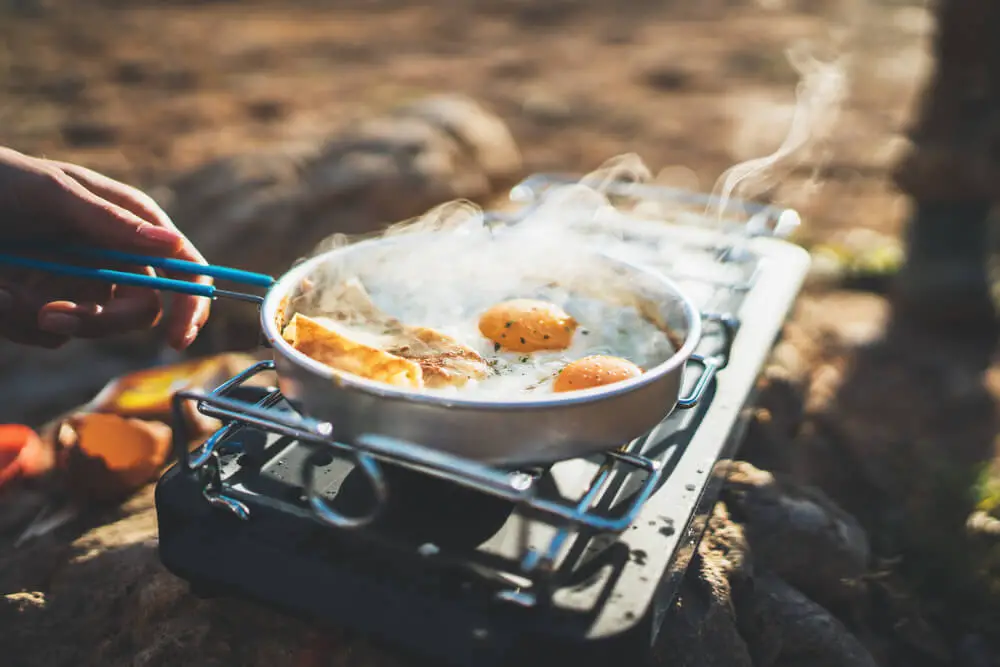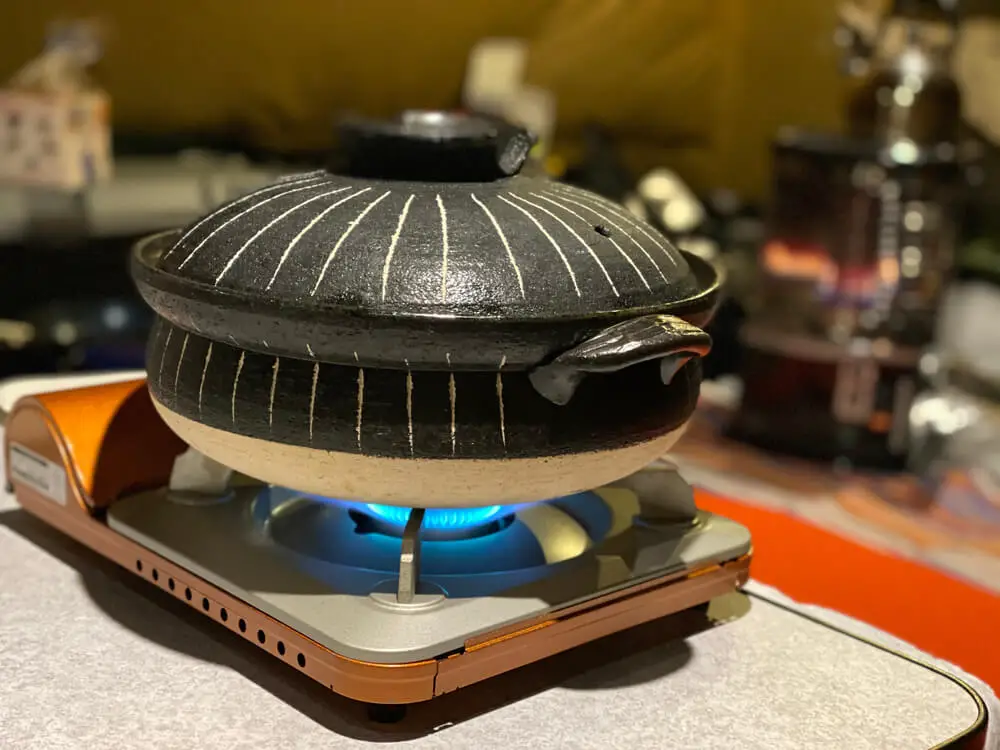Everyone has run into having no cooking option when staying at a small backcountry hut; what can be done. Or even when you have walked through a rainy day and get your tent set up but can't cook outside. All that's left to do is to cook inside, but is it possible?

Table of Contents
Can Camping Stoves Be Used Indoors?
Using a camp stove inside is very practical when your resources have been shut off, or you just haven't set up your kitchen stove yet.
Indeed, it is possible; however, it depends on many factors. For instance, you must take the proper safety precautions and know the differences between the types of fuel you would be using.
You can use any stove indoors, but you must keep in mind that carbon monoxide (CO) is not filtered to the same degree as with regulated kitchen stoves.
Standard kitchen stoves are designed to have the proper ventilation and meet specific code requirements.
When using higher quality camp stoves, you have better chances to avoid gas leakages and not have to worry about more CO getting into the air unmonitored.
Taking the proper precautions is vital, and we will get into that later on in the article.
You can absolutely use a camp stove inside, and at the very least, these are great to have around as a last resort. Obviously, you must keep the area you are using the stove clear of any paper, curtains, or other flammable items. It is best to just keep it in an area designated just for cooking.
Which Camping Stoves are Best Indoors?
Kerosene
While these are not as common as they once were, they are still a good source for a long burn with solid heat. This kind of camping stoves is not the most economical when factoring in the CO emissions. They have a very strong odor and are actually rather expensive, hence why they are being phased out of the camp stove market.
These are the horrible choice when looking at the option to cook inside; if this is all you have left, you can certainly use it but take every precaution possible. Most people would recommend against using these types of stoves indoors and certainly not in a tent.
Propane
One of the most common options on the market is propane camping stoves. Propane is used worldwide and is one of the safest options you can get anywhere.
Compared to kerosene, the smell is much nicer, but they can still emit as much carbon. Some of the higher-end propane camp stoves can emit no carbon monoxide, one reason they are so common on the market.
Propane burns at a higher temperature than kerosene, so it must be paid attention to, especially in an environment with little ventilation. Explosions are likely when the propane gets too hot. Make sure to use these in open areas.
Isobutane-Propane
These are little canisters you often see with backpackers or ultra-light travellers. Still, they are also usable on standard camp stoves. Just because they are small does not mean they cannot kill you.
The CO emitted from these tiny tanks is equivalent to any other type of fuel you can purchase, so it's not to be taken lightly.
It is a great option when you are heading into colder climates, as the butane remains a liquid even in sub-freezing temperatures. They are more expensive than the other options on this list, worth the money when considering the size and ability.
Make sure to have enough ventilation with this fuel to efficiently emit as much CO as kerosene.
Alcohol
An extremely lightweight option, they are cheaper and more eco-friendly than many of these other options.
With all these advantages, it is essential to note the CO emissions are higher than almost any other option.
In any tight space, they are extremely dangerous to use as they will fill the empty spaces quickly.
This is a great option to be using indoors with the caveat that you must make sure there is proper ventilation to dilute the CO emissions.
Wood Burning
This is an old-fashioned option that has been seeing a comeback of late because the fuel can be found in most places you would be camping.
Finding energy where you camp means you don't need to carry extra weight or take up more space in your backpack.
Concerning safety, it is still a hazard inside to have a fire where anything could be caught on fire and get out of hand. These also leave a considerable amount of debris to clean up afterward.
The CO emissions are less than many of these other options; however, it's hard to advocate this option as superior with the higher risk of catching something else on fire.
Safety
Some of the most significant hazards with using camp stoves indoors would be the dangers of carbon monoxide emissions and the risk of catching something else on fire. Easy ways to reduce these hazards are pretty apparent.
CO emissions can never be fully mitigated, but you can easily find strategies to use the camp stoves without worrying about the hazard. First of all, you can create ventilation for the carbon monoxide to flow out of you can feel better about getting poisoned.
As well as checking on the connections frequently, any type of gas leak will create a random variable that could sneakily get you poisoned. When the stove is running, it's harder to check connections, so before you even get things going, make sure everything is secure.
Another more significant hazard is to make sure you have a controlled flame at all times. With some of these stoves, a flame getting out of hand will be harder to happen. However, there is always a risk, so you always want to clear any area to dedicate to the camp stove. Anything from your sleeping bag to a loose-leaf or paper can ignite your whole tent or house in worst-case scenarios.

Rules for Tents
The first rule for using a camp stove in a tent is to open all air flaps in the tent. If you can leave the entrance, flysheet, and porch wide open can quickly increase your ventilation.
When raining, you may need to shut the flysheet. Still, it should be advised that only closing it enough to adequately protect the camp stove and keep the flame alive is necessary.
If you have your groundsheet underneath the tent, keep it back from the flame to prevent it from catching your tent on fire and ruining the camping experience.
If you have a tent with entrances on both sides of the tent, it would be a good idea to keep both of them open.
Make sure to place your stove in a very stable and secure location that will not be knocked over with any movement inside the tent that may stretch the fabric.
Stability is your best friend when it comes to keeping the flame under control. Most tents will come with ventilation ratings, so be sure to check these out to make sure your camp stove can operate and ventilate appropriately for the task at hand.
More Safer Alternatives
While denatured alcohol stoves and propane are great options for using your camp stoves indoors, they may not be the most appropriate for your needs. If you can't use these options, we'll get into some worthwhile alternatives when you are in a pinch and still need to eat.
Canned Heat or Sterno is a great option that comes as condensed alcohol and is easy to use. One of the hazards is that the flame is often transparent and difficult to register as active. When you cannot note if a flame is alive, you will be more careless, enabling you to carelessly handle the device. Always assume the flame is going, and never be sloppy.
An option without the need for a camp stove would be to find Meals Ready to Eat (MREs). These are what the army uses to because they are lightweight and able to travel in bulk quite easily. You never have to worry about the meals going wrong, and you need nothing other than a fork, maybe, to eat these.

Wrap-Up
To use a camping stove indoors is not something you need to be panicked about. Using camping stoves indoors are not entirely safe, but you are easily able to manage the situation.
Picking the proper fuel is an essential maneuver and takes the right strategies to make a completely safe environment.
Camping stoves are an excellent option for backpacking and even as just a backup to your standard kitchen stove. There should be no reason not to use them indoors if you are smart about it.
Hopefully, you have found what you are looking for with this article and can intelligently use your camp stove indoors in the future.
- Are Merrell Shoes Good? – An Unbiased Review of Merrell Footwear - December 9, 2023
- Where Are Merrell Shoes Made? - December 9, 2023
- Camping in 40-degree Weather: Tips and Tricks - September 25, 2023



![Can You Use a Propane Heater in a Tent? [Is It Safe?] Can You Use a Propane Heater in a Tent? [Is It Safe?]](https://grandcircletrails.com/wp-content/uploads/2022/06/Can-You-Use-a-Propane-Heater-in-a-Tent-150x150.jpg)

![How to Insulate a Camper for Winter Use? [Most Cost-Efficient Ways] How to Insulate a Camper for Winter Use? [Most Cost-Efficient Ways]](https://grandcircletrails.com/wp-content/uploads/2022/10/How-to-Insulate-a-Camper-for-Winter-Use-150x150.jpg)
